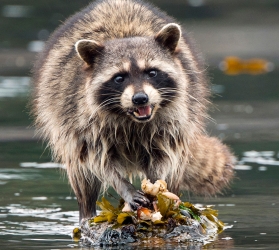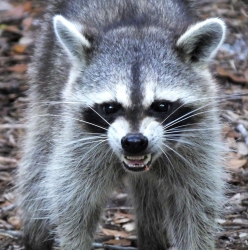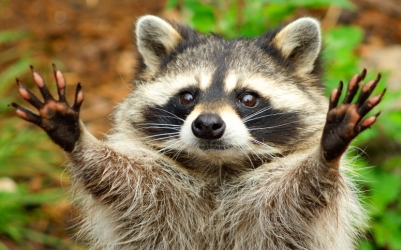  Raccoons are common throughout North America from Canada to Panama. The raccoon is the largest of the procyonid family, having a body length of 40 to 70 cm and weighing anywhere from 5 to 26 kg. Its grayish coat is mostly dense underfur, which insulates it against cold winter weather.
Raccoons are common throughout North America from Canada to Panama. The raccoon is the largest of the procyonid family, having a body length of 40 to 70 cm and weighing anywhere from 5 to 26 kg. Its grayish coat is mostly dense underfur, which insulates it against cold winter weather. Three of the raccoon's most distinctive features are its very dexterous front paws, its black 'eye mask', and its ringed tail. The raccoon is noted for its intelligence and problem solving ability. Raccoons are a familiar sight just about everywhere, because they will eat just about anything!  These nocturnal mammals are found in forests, marshes, prairies, and even in cities. They are adaptable, and use their dexterous front paws and long fingers to find and eat a wide variety of meals.
These nocturnal mammals are found in forests, marshes, prairies, and even in cities. They are adaptable, and use their dexterous front paws and long fingers to find and eat a wide variety of meals. They are omnivorous; in the wild, raccoons find a lot of their food in the water. They use their paws to grab crayfish, frogs, and other aquatic creatures. On land, they grab mice and insects, and most especially like to raid nests for eggs. The raccoon's paws lack an opposable thumb, so it does not have the agility of the hands of primates. Raccoons also eat fruit and plants, including those grown in human gardens and farms. They will open garbage cans to dine on the contents. During winter in cold northern climates, raccoons sleep for extended periods, although they don't actually hibernate. To prepare for cold winters, raccoons pack on extra body fat in the fall. This extra fat helps provide the raccoon with energy when it's too cold to search for food. For climbing down a tree headfirst, an unusual ability for a mammal of its size, a raccoon rotates its hind feet so they are pointing backwards.  One raccoon behavior is so well known that it gives the animal part of its scientific name, Procyon lotor; 'lotor' is Latin for 'washer'. In the wild, raccoons often dabble underwater for food near the shore-line. They pick up the food item with their front paws to look at it and rub it, sometimes to remove unwanted parts. This makes it look like the raccoon is 'washing' the food. However, this behaviour has not been observed in the wild.
The accepted theory is that dousing in captive raccoons is a fixed, reflexive pattern from the dabbling behavior performed when foraging at water's edge for aquatic foods. This is supported by the observation that aquatic foods are doused more frequently. Cleaning dirty food does not seem to be a reason for 'washing'.
One raccoon behavior is so well known that it gives the animal part of its scientific name, Procyon lotor; 'lotor' is Latin for 'washer'. In the wild, raccoons often dabble underwater for food near the shore-line. They pick up the food item with their front paws to look at it and rub it, sometimes to remove unwanted parts. This makes it look like the raccoon is 'washing' the food. However, this behaviour has not been observed in the wild.
The accepted theory is that dousing in captive raccoons is a fixed, reflexive pattern from the dabbling behavior performed when foraging at water's edge for aquatic foods. This is supported by the observation that aquatic foods are doused more frequently. Cleaning dirty food does not seem to be a reason for 'washing'.
 After a gestation period of about 65 days, two to five young known as 'kits' are born in spring. The kits are raised by their mother until late fall.
After a gestation period of about 65 days, two to five young known as 'kits' are born in spring. The kits are raised by their mother until late fall. On land, raccoons move around on all four paws like a bear. They are excellent climbers, not only of trees, but also of urban buildings like homes, cottages, and sheds. Raccoons are excellent swimmers, hunting fish, frogs, and crayfish. Raccoons live for around one to three years in the wild. In captivity, where the raccoon doesn’t need to worry about finding food, some have lived as long as 20 years. In many areas, hunting and vehicular injury are the two most common causes of death.  Raccoons are particularly notorious in urban areas for consuming food waste. They have impressive problem-solving abilities, and can break into all but the most secure garbage bins, which has earned them the nickname 'trash panda'. Raccoons living in in close proximity to humans may be undesirable, as raccoon droppings, like most wild animals, contain parasites. Raccoons are particularly notorious in urban areas for consuming food waste. They have impressive problem-solving abilities, and can break into all but the most secure garbage bins, which has earned them the nickname 'trash panda'. Raccoons living in in close proximity to humans may be undesirable, as raccoon droppings, like most wild animals, contain parasites.Raccoons usually don't prey on domestic cats and dogs. While overturned waste containers are just a nuisance to homeowners, it can cost thousands of dollars to repair damage to roofs and attic space used for dens. Nevertheless, relocating or killing raccoons without a permit is forbidden in most urban areas.  |